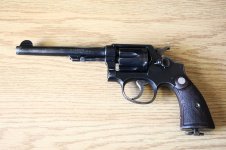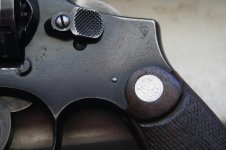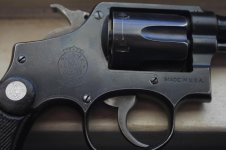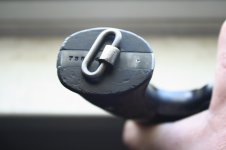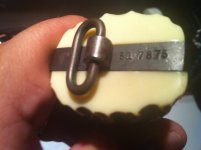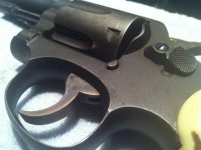Hi,
I would like to contribute to your database and share with others.
I have a .38/200 S&W SN#736774 with the letter P stamped on the butt
Mr Jinks has told me that this revolver was shipped in Feb of 1941. I do not have any other details other than that.
I would like to know about the arrow located on the top right of the receiver in the photo. Anybody? If anyone else has info/comments, please share.
I bought this with original ammo dating from about the 1950's
Rob
Edited:
The barrel shows wear, possible from being excessively holstered?
I can't add a great deal. From the SN, the 2/41 shipping date appears correct. The marking is likely the British Ordnance "Broad Arrow" stamping, indicating Crown ownership. It appears that there is a partial circle around the broad arrow. Other similar markings I have seen do not have a circle. Canadian guns have a broad arrow inside the letter C, but I don't think that is what this one is. Others may be able to better identify this specific broad arrow marking. In any event, it is a property marking.
There is likely no way to trace where yours went after it left the factory, as it could have ended up anywhere on the globe. A factory letter ($50) would provide the first location shipped, but even that could be misleading, as they were often sent elsewhere. The British shuffled their firearms around a great deal, according to where the need was greatest.
At this time, the .38/200 military order revolvers were finished identically as civilian revolvers, including a bright blue (Carbonia) metal finish and checkered wooden grips with medallions. During the time period when yours was made, S&W was producing very few guns aside from .38/200 revolvers for the British Commonwealth. Yours appears correct for the period, and was made prior to the Lend-Lease Act of 1941, so it was actually purchased for gold, or possibly as part of a "rebate" program, where S&W provided revolvers in lieu of a cash refund for a failed 9mm automatic carbine contract S&W had with the British.
Collectors call these revolvers "pre-Victories" as they were produced for foreign military use prior to the adoption of the V (for Victory) serial number prefix. Those Victory model revolvers started shipping about the middle of 1942. Hopefully, its chambers have not been bored to accept .38 Special ammunition. The .38 S&W cartridge was the official revolver cartridge adopted prior to WWII. There were two varieties, the .380 Revolver Mk1 and Mk2. The Mk1 used a 200 grain lead bullet. The Mk2 came later, and used a 178 grain FMJ bullet. This was to meet the requirements of the Hague Conventions which prohibited expanding bullets in warfare. You will find .380 Revolver ammunition made about everywhere in the British Empire. Those made in Great Britain, India, and South Africa are probably the most common. .38 S&W, .380 Mk1, and .380 Mk2 cartridges are interchangeable, but not strictly identical.

